| Lear Home |
| Applying for Studies |
| Biography |
| Courses |
| People in OptoE |
| Publications |
| Research |
| Useful Links |
| Visitor Info |





(c) 2006
Kevin Lear
All rights reserved
The CSU Optoelectronics Group led by
Prof. Lear is pursuing research on both vertical cavity and
planar waveguide based optoelectronic devices and systems with
applications to photonic biosensors and optical communications.
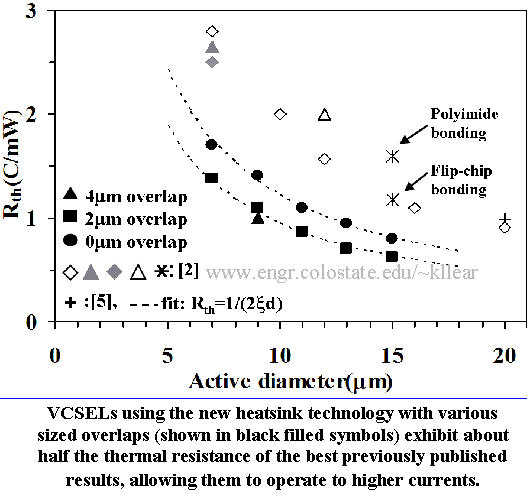
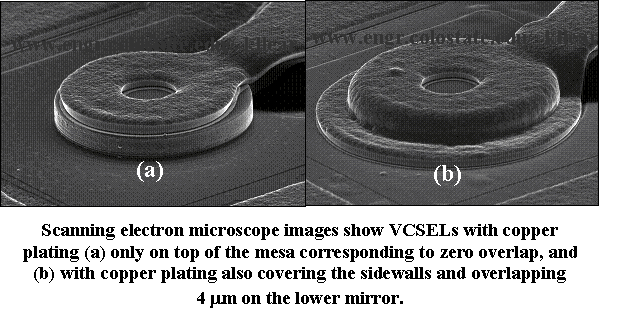
A progression of experiments are validating expected phenomena underlying concepts for a new type of biosensor. The local, evanescent, array-coupled (LEAC) biosensor is a label-free immunoassay device similar to existing ones that use the binding of target antigens to antibodies on a waveguide. When anitgens bind, i.e. attach, to the sensitized surface, their presence alters the optical fields in the waveguide. While others then use observations of the optical intensity or phase measured at the end of the waveguide, the LEAC biosensor detects the shift in the confined mode locally by sensing the change in evanescent coupling to a detector buried under the waveguide. The LEAC acronym is motivated by the image of the antigens controlling the "leakage" of light to the detector. End-sensing allows only a single sensing region per waveguide while local sensing enables detection of many antigens using tens or hundreds of different antibody patches along the waveguide with a corresponding detector opposite each patch. Prior work on a proof-of -concept device using an increased thickness of silicon nitride (n=1.8) as a pseudo-antigen layer appeared in a Photonics Technology Letters paper. More recently, NSOM measurements of the evanescent field along a waveguide with a 100 nm thick, 10 micron, long low index, photoresist feature agree with BPM simulations providing further support that the LEAC waveguide sensor concept is valid. This research program is supported by NIH.
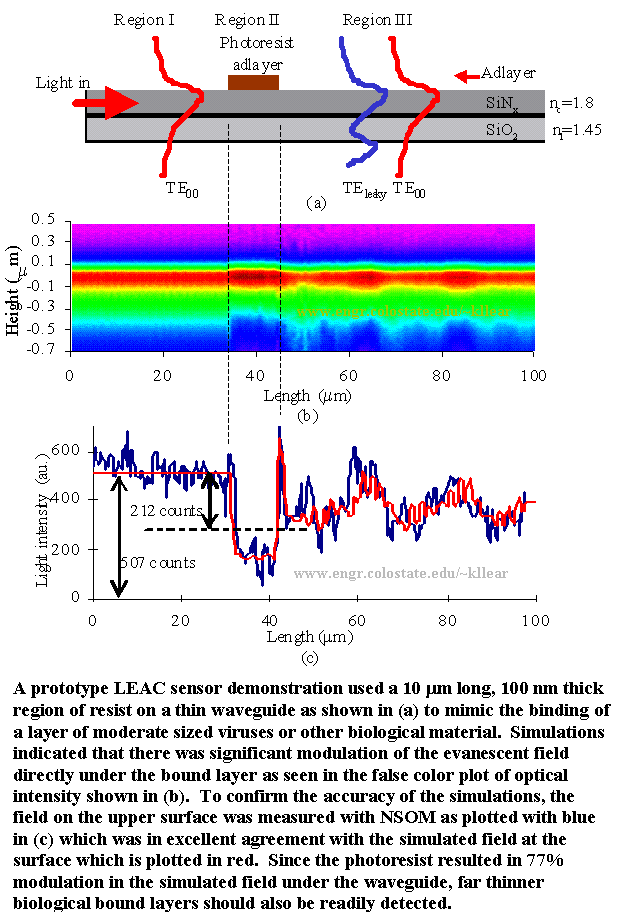
Optical components including waveguides and photodetectors for on-chip
optical interconnects have been successfully fabricated in a commercial
CMOS process through an industrial collaborator. The
technology
is initially designed for clock distribution
in high
end CMOS processor chips. As seen in the
photograph
below, light is launched in a waveguide at the edge of the chip that is
routed to multiple receiver nodes via an H-tree structure.
Leaky-mode coupling with the highest effective absorption coefficient
of silicon waveguide detectors measured to date (0.56 dB/um) has been
achieved giving good estimated responsivities of 0.34 A/W in a 10
micron long detector. A chip
with electronics for measuring the skew in the optical clock
distribution system is currently being fabricated. This work is
supported by NSF and is part of their GOALI programs.
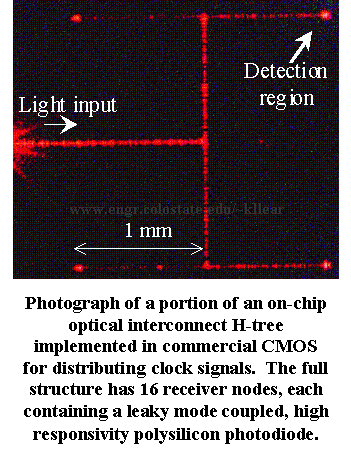
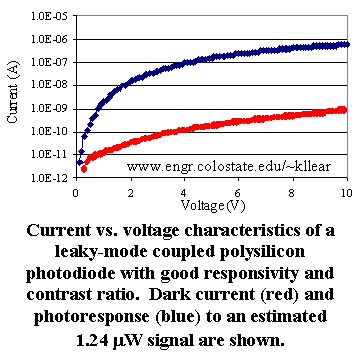
A passive cavity approach to performing optofluidic intracavity spectroscopy simplifies the sensor system relative to previous external cavity laser implementations. The device is based on the treatment of cells in an aqueous environment as lenses due to their higher index and curved interface with the fluid. Paul Gourley and colleagues at Sandia National Laboratories demonstrated that placing cells in the cavity of a photopumped VCSEL generated unique spectral features such as the number, spacing, and offset of multimode spectra that could be used to distininguish different types of cells. The CSU optoelectronics group subsequently demonstrated an electrically driven laser diode version. However, the active cavity sensors place relatively high demands on the laser to overcome the loss associated with the fluid filled external cavity, and to integrate the laser diode with the microfluidics system. These challenges motivated the passive cavity system that relies on the transmission spectra of a cavity taken using an external LED as the continuum light source. This system has been used to obtain spectra of red and white blood cells, yeast, and polystyrene spheres as discussed in a paper to appear in the IEEE Sensors Journal. The spectra of red blood cells in particular were found to be well correlated and allowed their quantitative differentiation with respect to white blood cells. Thus, this technology may be appropriate applications such as unstained whole blood counts in a lab-on-a-chip environment. This work was supported by DARPA's university optoelectronic centers program.
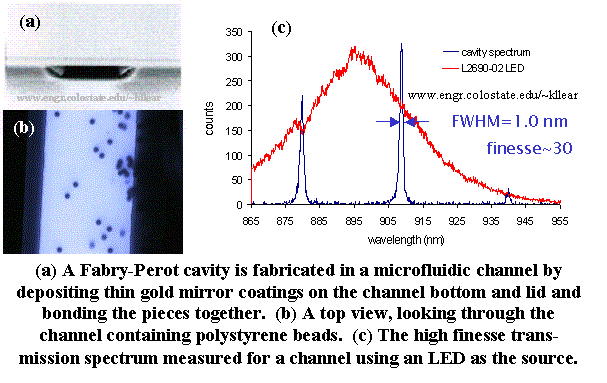
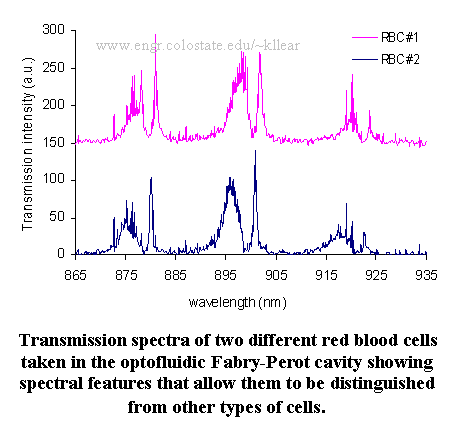
 |
Technology |
|||
|---|---|---|---|---|
Planar Waveguide
|
Vertical Cavity |
Other |
||
|
|
 |
|||
 |
||||
Optofluidic intracavity spectroscopy (OFIS)
Passive Fabry-Perot cavities integrated with a microfluidic channel are being investigated for use in cell detection and differentiation using a technique we call optofluidic intracavity spectroscopy (OFIS). Some recent publications on this project are:- “Single Cell Detection Using Optofluidic Intracavity Spectroscopy” by H. Shao, D. Kumar, and K. L. Lear, to appear in IEEE Sensors Journal, 2006.
- “Fabrication of a Fabry-Perot
Cavity in a Microfluidic Channel Using Thermocompressive Gold Bonding
of Glass Substrates” by
H. Shao, D. Kumar, S. Feld, and K. L. Lear, IEEE Journal of
Microelectromechanical Systems, vol. 15, pp. 756-762,
August, 2005.
- “Single Cell Detection
Capability of an Optofluidic Intracavity Spectroscopic Biosensor”
by H. Shao, D. Kumar,
and K. L. Lear, 4th IEEE International
Conference on Sensors, paper A2L-C, Irvine, California,
pp. 183-186, October 31, 2005.
- Also, see the research
highlight below on cell differentiation.
Fluidic intracavity laser diode (FILD) sensor
There is also an active cavity version of OFIS using fluid filled external cavity electrically driven laser diodes called the fluidic intracavity laser diode (FILD) sensor. Get it? "filled"? A recent publication on this project is:- “Microfluidic cavity surface
emitting laser based biosensor” by D.
Kumar, H. Shao, and K.L. Lear,
IEEE LEOS 17th
Annual Meeting, vol. 1, pp. 118-119, Puerto Rico, November
7-11, 2004.
Local evanescent array coupled (LEAC) waveguide biosensor
A very promising multianalyte immunoassay biosensor is being developed based on a new concept in waveguide sensors. The sensor design allows tens to hundreds of biomolecular targets to be recognized by binding to different regions where they will be locally detected by evanescent coupling to an array of photodetectors. The acronym, LEAC, is meant to evoke the notion of the bound targets controlling the amount of light "leaking" into each of the photodetector array elements. Near-field scanning optical microscopy (NSOM) has been a key tool for characterizing the response of optical fields to small islands of material patterned on waveguides to mimic bound biological layers. This work is in collaboration with Prof. David Dandy in CSU's Chemical Engineering Department and Profs. David Grainger and Alan van Orden in CSU's Chemistry Department. Some recent publications on this project are:- “Direct imaging of transient
interference in a single mode waveguide using NSOM”
by G.W. Yuan, M.D.
Stephens, D.S. Dandy, and K.L. Lear, IEEE Photonics Technology Letters,
vol. 17, pp. 2382-2384, November, 2005.
- “Initial demonstration of a
local, evanescent, array coupled biosensor” by G.
Yuan, M. Stephens, D.S. Dandy, and K.L. Lear,
4th IEEE
International Conference on Sensors, paper B4P-G, Irvine,
California, October 31, 2005.
- Also, see the research highlight below on LEAC sensor concept validation experiments.
On-chip optical interconnects in commercial CMOS
Another project using planar waveguide technology is aimed at demonstrating on-chip optical clock distribution to meet the challenges of growing interconnect bottlenecks with each generation of high performance processor chips. Taking an approach that can be fabricated in commercial CMOS makes this technology more likely to be adopted in the near term. Some recent publications on this project are:- “Waveguide coupled CMOS
photodetector for on-chip optical interconnects”
by A.M. Raza, G.W.
Yuan, C.K. Thangaraj, T. Chen, and K.L. Lear, IEEE LEOS 17th Annual Meeting,
vol. 1, pp. 152 – 153, Puerto Rico, November 7-11,
2004.
- Also, see the research highlight below on the initial demonstration and on-chip H-tree.
High speed VCSELs for chip-to-chip optical interconnects (C2OI)
VCSEL technology dominates the LAN and SAN fiber optic links and is also attractive for short distance optical communication between components such as between processor chips on the same board. Prof. Lear has been researching high speed VCSELs for a decade including developing 21 GHz ones at Sandia. As VCSELs are the most bandwidth limited components in short distance optical interconnects, this research in this project endeavors to raise the direct modulation bandwidth of VCSELs to 40Gb/s, and thus move short distance optical interconnects well past the capabilities of copper traces. Some recent publications on this project are:- “Low Thermal Resistance, High
Speed, Top Emitting 980nm VCSELs” by A.
Al-Omari, G. P. Carey , S. Hallstein, J. P. Watson, G. Dang, and K. L.
Lear, to appear in IEEE Photonics Technology Letters,
vol. 18, 2006.
- “Dielectric Characteristics of Spin-Coated Films Using On-Wafer Parallel-Plate Capacitors at Microwave Frequencies” by A. Al-Omari and K. L. Lear, IEEE Transactions on Dielectrics and Electrical Insulation, vol. 12, pp. 1151-1161, December, 2005.
- “VCSELs with a Self-Aligned Contact and Copper-Plated Heatsink” by A. Al-Omari and K. L. Lear, IEEE Photonics Technology Letters, vol. 17, pp. 1767-1769, September, 2005.
- “Polyimide Planarized, Vertical-Cavity Surface-Emitting Lasers with 17.0 GHz Bandwidth” by A. Al-Omari and K. L. Lear, IEEE Photonics Technology Letters, vol. 16, pp. 969-971, April, 2004.
- Also, see the research highlight below on record low thermal resistance VCSELs.
Non-linear effects in VCSEL based multimode fiber links
While VCSEL speeds define the bandwidth of optical interconnects at the board level, non-ideal properties of legacy multimode fiber are the biggest limit for higher data rate LAN and SAN applications, particularly as VCSELs get faster. Associated studies in the CSU Optoelectronics Group have examined the impact of non-linearities in VCSELs, specifically the pattern dependence of beam divergence, on multimode fiber links. Some recent publications on this project are:- “Nonlinear Equalization of Multimode Fiber Links Considering VCSEL Non-Idealities” by S. Al-Sowayan and K. L. Lear, OSA Annual Meeting/2005 Frontiers in Optics/ Laser Science Conference, paper FThE5, Tucson, AZ, October 16-20, 2005.
- “Data Pattern Dependence of
VCSEL Far-Field Distributions” by S.
Al-Sowayan and K. L. Lear, IEEE Photonics Technology Letters,
vol. 16, pp. 2215-2217, October, 2004.
Fluorescence based fiber optic sensors
Research in the area of engineering optoelectronics instrumentation for fiber optic sensors is being performed in collaboration with Prof. Reardon of CSU's Chemical Engineering Department. Prof. Reardon is investigating the use of genetically engineered bacteria or their enzymes to metabolize target pesticides that can be sensed through fluorescence. The Optoelectronic Research Group's major role in this project is to develop high sensitivity, field-portable instrumentation and related system models for the fiber optic sensors. The effort will accelerate in the fall of 2006 due to a recent NSF award.Research Highlights
Extending plated copper heatsinks over the mesa side wall on top-emitting VCSELs reduces the thermal resistance by 29% compared to identical devices where the copper plating is restricted to the top of the mesa, indicating the importance of lateral heat transport in mirror stacks. Devices with 9 micron diameter oxide apertures had thermal resistances as low as 1.0 C/mW, half the best previously published results. The reduction in thermal resistance with sidewall heatsinks increased the maximum power of the test lasers laser bandwidth by 131% with an associated 40% increase in bandwidth. Details are available in a paper to appear in Photonics Technology Letters. This work is sponsored by DARPA's C2OI program.

A progression of experiments are validating expected phenomena underlying concepts for a new type of biosensor. The local, evanescent, array-coupled (LEAC) biosensor is a label-free immunoassay device similar to existing ones that use the binding of target antigens to antibodies on a waveguide. When anitgens bind, i.e. attach, to the sensitized surface, their presence alters the optical fields in the waveguide. While others then use observations of the optical intensity or phase measured at the end of the waveguide, the LEAC biosensor detects the shift in the confined mode locally by sensing the change in evanescent coupling to a detector buried under the waveguide. The LEAC acronym is motivated by the image of the antigens controlling the "leakage" of light to the detector. End-sensing allows only a single sensing region per waveguide while local sensing enables detection of many antigens using tens or hundreds of different antibody patches along the waveguide with a corresponding detector opposite each patch. Prior work on a proof-of -concept device using an increased thickness of silicon nitride (n=1.8) as a pseudo-antigen layer appeared in a Photonics Technology Letters paper. More recently, NSOM measurements of the evanescent field along a waveguide with a 100 nm thick, 10 micron, long low index, photoresist feature agree with BPM simulations providing further support that the LEAC waveguide sensor concept is valid. This research program is supported by NIH.

Monolithic optical interconnect with high responsivity polysilicon detectors fabricated in commercial CMOS


A passive cavity approach to performing optofluidic intracavity spectroscopy simplifies the sensor system relative to previous external cavity laser implementations. The device is based on the treatment of cells in an aqueous environment as lenses due to their higher index and curved interface with the fluid. Paul Gourley and colleagues at Sandia National Laboratories demonstrated that placing cells in the cavity of a photopumped VCSEL generated unique spectral features such as the number, spacing, and offset of multimode spectra that could be used to distininguish different types of cells. The CSU optoelectronics group subsequently demonstrated an electrically driven laser diode version. However, the active cavity sensors place relatively high demands on the laser to overcome the loss associated with the fluid filled external cavity, and to integrate the laser diode with the microfluidics system. These challenges motivated the passive cavity system that relies on the transmission spectra of a cavity taken using an external LED as the continuum light source. This system has been used to obtain spectra of red and white blood cells, yeast, and polystyrene spheres as discussed in a paper to appear in the IEEE Sensors Journal. The spectra of red blood cells in particular were found to be well correlated and allowed their quantitative differentiation with respect to white blood cells. Thus, this technology may be appropriate applications such as unstained whole blood counts in a lab-on-a-chip environment. This work was supported by DARPA's university optoelectronic centers program.


